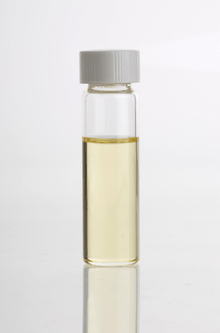Oil of clove
Oil of clove, also known as clove oil, is an essential oil extracted from the clove plant, Syzygium aromaticum. It has the CAS number 8000-34-8.

Clove is often found in the aromatherapy section of health food stores, and is used in the flavoring of some medicines. Madagascar and Indonesia are the main producers of clove oil.[1]
Clove oil has been promoted as having a wide range of health effects, but although the local anaesthetic properties are well documented there is insufficient medical evidence to support general claims for its use as a therapeutic.[2] In Australia clove oil has been the cause of an increase in reported cases of children being poisoned.
Types
There are three types of clove oil:[1]
- Bud oil is derived from the flower-buds of S. aromaticum. It consists of 60–90% eugenol, acetyl eugenol, caryophyllene and other minor constituents.
- Leaf oil is derived from the leaves of S. aromaticum. It consists of 82–88% eugenol with little or no eugenyl acetate, and minor constituents.
- Stem oil is derived from the twigs of S. aromaticum. It consists of 90–95% eugenol, with other minor constituents.
Uses
Toothache
Particularly in South Korea and India, eugenol, a phytochemical extracted from clove oil, is used to relieve toothache.[3] Applied to a cavity in a decayed tooth or tooth socket remaining after extraction, eugenol or clove oil can relieve toothache temporarily.[3]
In the United States, the FDA considers eugenol ineffective for treating dental pain, and has downgraded clove oil as an analgesic due to insufficient evidence to rate its effectiveness.[2]
Use on fish
Clove oil is commonly used to anesthetize or euthanize laboratory or pet fish.[4][5]
Toxicity
In Australia clove oil is one of the many essential oils that have been increasingly causing cases of poisoning, mostly of children. In the period 2014-2018 there were 179 reported cases in New South Wales, accounting for 4.1% of essential oil poisoning incidents.[6]
Eugenol, the major component, is hepatotoxic and may cause damage to the liver. Overdose is also possible.
Regulation
In Germany, Commission E permits the sale and administration of clove oil as a medicinal herb.[7]
References
- Lawless, J. (1995). "The Illustrated Encyclopedia of Essential Oils: The Complete Guide to the Use of Oils in Aromatherapy and Herbalism". The Illustrated Encyclopaedia of Essential Oils. ISBN 978-1-85230-661-8.
- "Clove". MedlinePlus. NIH.
Clove oil and eugenol, one of the chemicals it contains, have long been used topically for toothache, but the FDA has reclassified eugenol, downgrading its effectiveness rating. The FDA now believes there isn't enough evidence to rate eugenol as effective for toothache pain.
- Chung G, Oh SB (2013). "Eugenol as Local Anesthetic". Natural Products. Springer-Verlag Berlin; In: Natural Products - Phytochemistry, Botany and Metabolism of Alkaloids, Phenolics and Terpenes; Part XIV. pp. 4001–4015. doi:10.1007/978-3-642-22144-6_171. ISBN 978-3-642-22144-6.CS1 maint: uses authors parameter (link)
- Gary Kent Ostrander (2000). The Laboratory Fish. Elsevier. pp. 508–. ISBN 978-0-12-529650-2.
- Gary West; Darryl Heard; Nigel Caulkett (21 July 2014). Zoo Animal and Wildlife Immobilization and Anesthesia. Wiley. pp. 249–. ISBN 978-1-118-79286-5.
- Lee KA, Harnett JE, Cairns R (2019). "Essential oil exposures in Australia: analysis of cases reported to the NSW Poisons Information Centre". Medical Journal of Australia. doi:10.5694/mja2.50403. ISSN 0025-729X. Lay summary.
- Rister, R.; Klein, S.; Riggins, C. (1998-08-15). The Complete German Commission E Monographs: Therapeutic Guide to Herbal Medicines (1st ed.). American Botanical Council. p. 112. ISBN 978-0-9655555-0-0.